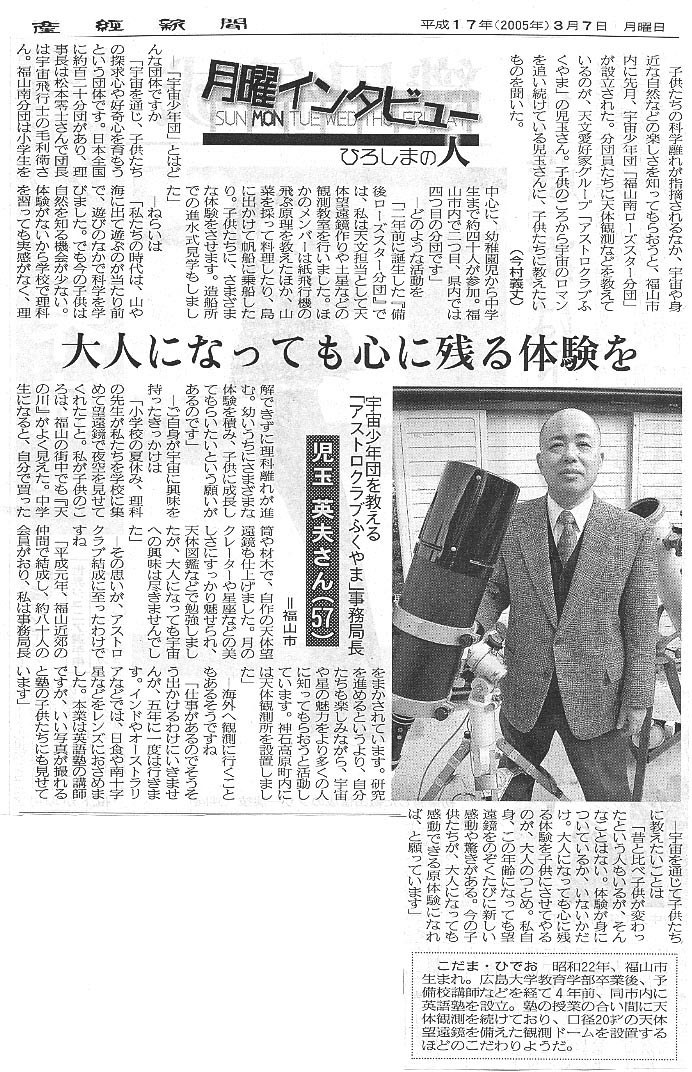
| 講師プロフィール |
 |
|
|
![]() 福山市明治町生まれ。
福山市明治町生まれ。
![]() 南小学校→広大附属福山中・高等学校→広島大学教育学部高校教員養成課程外国語科(英語)卒
南小学校→広大附属福山中・高等学校→広島大学教育学部高校教員養成課程外国語科(英語)卒
![]() 予備校講師、高校講師(広大附属福山、広島附属、市立福山、誠之館、葦陽等)を経験。
予備校講師、高校講師(広大附属福山、広島附属、市立福山、誠之館、葦陽等)を経験。
![]() 英検一級。TOEIC(Test of English for International Communications)855点
英検一級。TOEIC(Test of English for International Communications)855点
(Hearing400点、 Reading455点)
![]() 趣味:天体写真。
趣味:天体写真。
| 塾長挨拶:私が今まで体験してきたこと、蓄積してきたものが、少しでも次の世代の役に立てば本望です。
|
![]() しまなみ海道チャリンコ走破にチャレンジしてきました
しまなみ海道チャリンコ走破にチャレンジしてきました
画像をクリックすると、全貌を見ることが出来ます(2002年9月21日)
私の写した天体写真と撮影エピソード
以下の天体写真と英文の撮影エピソードは、
2011年5月にオランダのライデン市でおこなった天体写真展のものです。
ライデン大学の日本語学教授(左の黒い上着の男性)と
私が写したコロナの写真を持つオランダの子供たち。


My Astronomy Photos and Episodes
Originally Exhibited in Leiden, the Netherlands in May, 2011
01. Big
Presents for a
Small
Kindness
(Total Solar Eclipse in Mexico, 1991)
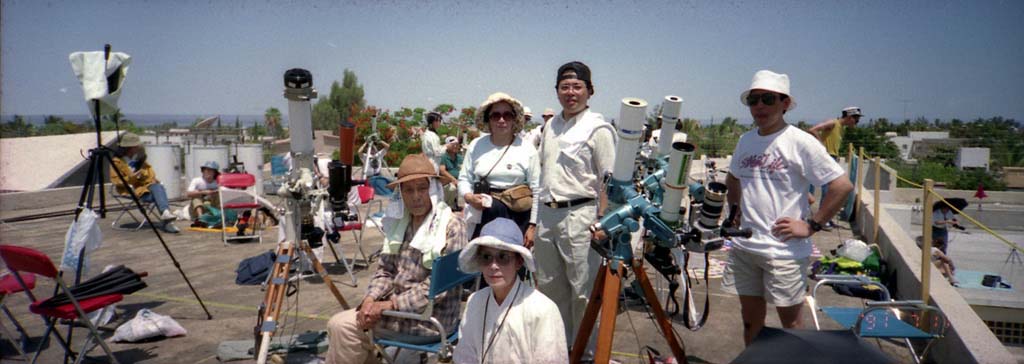
On July 11, 1991, I went to La Paz
Mexico to see the total solar eclipse, where I happened
to meet for the first time, Mr. Asada, he was staying in the next room. Mr.
Asada bought a
new tripod for this event not knowing it was impossible to aim his lens to the
sun at the zenith.
So, I removed one of my cameras from my equatorial ( a tripod especially made
for tracing
the movement of heavenly bodies) and let him put his camera there. During the
first half of
the eclipse, while Mr. Asada took his pictures, I enjoyed observing the
remarkable prominence
and the corona through a small telescope. In the latter half of the eclipse, I
took my pictures,
while Mr. Asada observed the eclipse through his 11 x 70 binoculars. It was the
second longest
eclipse in the 20th century.
Mr. Asada and I happened to come from
the same prefecture in Japan , Hiroshima. When we
came home, we continued our relationship, he joined our astronomy club and
sometimes joined
in the star parties. We also went to Australia to enjoy star watching. He
later entrusted me
with two of his major telescopes, 25cm Newtonian and 15cm fluorite triplet
refractor, saying he
was too old to use them. They are worth five million yen (about 40 thousand
Euros). He also
assisted me financially in building an observatory to house those telescopes.
He was one of the top engineers of coal mines, and made a great
contribution to the revival
of Japan after World War II. In 2011, he passed away at the age of
97.
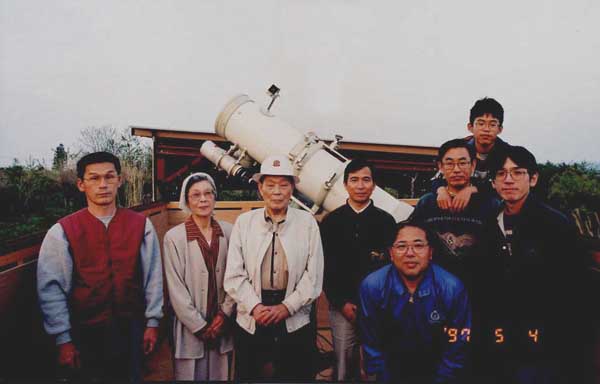
02. New
Image from an Old Film, One Saros Later
(Total Solar Eclipse, Mexico, 1991 to 2009 Eclipse,
Japan)

On July 11, 1991, I took a photo of the
total solar eclipse in La Paz, Mexico on a large format film.
Many people went to Hawaii to see the eclipse, but I decided that the
possibility of fine weather
was higher in Baja California, Mexico. It was a difficult journey, because many
people from all over
the world rushed to the best spot, La Paz. Our large tour group (there were more
than one hundred
of us) managed to get to the city, but to our surprise and anger, we had to stay
at a convent,
instead of the beautiful hotel where we were supposed to stay.
In order to take a good photo, I used a
refractor telescope with 102mm fluorite lens, which is
color aberration free. To use a large format camera, Pentax 6X7, I had an
adaptor made.
To obtain a large image of the sun, I bought a converter lens to make the focal
length twice as long,
1800mm, thus making the disc of the sun on the film about 18mm across. I took
care that it will not
be out of focus. I brought a heavy equatorial to keep the sun in the vision
automatically. My total
luggage was 50 kilograms. To avoid the vibration from the mirror and the
shutter of the camera,
I held a black board in front of the lens and used it as a shutter. The
exposure was 1 second.
I selected a film with wide latitude; Fuji negative 160. As a result, I took a
better picture than others.
But when it was printed on a paper, the pink prominences disappeared in the
bright inner corona.
The fine stream line of the corona did not show on the film.
Eighteen years later, however, as I was
processing July 22, 2009 eclipse image, I tried scanning my
old film with four different exposures and stacked the images on a computer. I
also processed those
images with rotational gradation method, and the fine stream lines of the corona
appeared. Though
the photo is not as good as is seen with the naked eye, I obtained a new image
from my old film one
saros later (18 years and 11and 1/3 days. at which interval similar solar
eclipse occurs).
03.
A
Perfect Photo
India, 1995

On October 24, 1995, in India, I took a perfect photo of the whole process of a
total
solar eclipse. Four years before, in Mexico, I saw a girl taking a photo of the
process
of a solar eclipse in one frame of a film. I asked the girl for a copy of that
photo, and
obtained it in exchange for my close up shot of the eclipse. Though her photo
was only
the central part of the eclipse, it was so beautiful that I was determined to
take a photo
of the entire process.
We need lucky coincidence of many conditions in order to take this kind of
photo.
First, the sky must be clear through the entire process of two and a half
hours.
Second, the camera must not move till the end and nobody should kick the
tripod.
Third, during the eclipse, you must remove the filter, this is necessary to take
the partial
phase, one should not forget to put it back as soon as the total phase is over.
Fourth, you should push the shutter exactly on time; I pushed the shutter 31
times
at exactly five minute intervals, plus nobody should be standing in front of
your camera.
Fifth, in the frame of the film, the sun should be so placed that it will not go
out of the frame
until the end of the eclipse. Sixth, you should be able to charge and push the
shutter without
winding up the film. There is plenty of room for errors, and you should satisfy
all these
conditions to take this single frame of photo.
For this photo, I got a camera second hand; Mamiya
Universal Press with 100mm F2.8 lens;
you can charge and push the shutter without winding the film; its film format is
as large as
6X9 centimeters. I used the finest grain film available: Ectar ISO25 negative.
I secured the
best position on the roof of the hotel the previous night, so nobody would stand
in front of
the camera or kick the tripod. I set an alarm clock for 4 minutes every time I
pushed the
shutter so that I might not forget to press the shutter the next time. During
the totality of
40 seconds, I did not forget to remove the solar filter, though I forgot to
remove the filter of
my video camera. After the totality, the other people began to pack up their
telescopes and
cameras to go home, but I kept on pushing the shutter for another one hour and
fifteen minutes,
and this is the incredible result.
This photo was published in an astronomy magazine “Tenmon Guide” (January
1996).
04. Prevented by Snow
(Comet Hale-Bopp)

On March 18 ,1997 I photographed Comet
Hale-Bopp in the mountains near my home
in Fukuyama Mr. Hale and Mr. Bopp, amateur astronomers, independently
discovered
the comet when it was still around the orbit of Jupiter. It was a giant. We
had been
excitedly waiting for the comet to approach the sun for nearly two years.
On The previous evening just 90 minutes
after I went to bed, I got up again in the middle
of the night. The sky was clear, and I began to drive toward the observatory in
the mountains.
As I approached the destination, it began to snow. I had to come home
disappointed.
On
the next night, March 18, I drove up the mountain again. Fortunately the sky
was
exceptionally clear. Before the dawn, Comet Hale-Bopp began to rise above the
horizon
with the Milky Way. I put the Milky Way across the frame and photographed the
comet.
With a 300mm lens which I borrowed from my brother, I took a close-up picture of
the comet, too.
In the white dust tail, synchronic band, which is peculiar to a giant comet, was
seen, and together
with the blue ion tail, the comet formed a V-shape. Both pictures won prizes in
a contest
sponsored by Nishiwaki City.
05.
A Shooting Star
Inspires a Girl
(Big shooting star, 1998)

On November 18, 1998, I took a photo of one of the big
shooting stars of the Leonids
meteor shower. It is not easy to record a shooting star on a film even if it’s
visible with
your naked eye; they are so faint and move too fast. This shooting star,
however, was
so big that everything around me was illuminated as brightly as in broad
daylight.
The star shot through the big triangle of winter, leaving something like a trail
of smoke
for nearly a minute. This photo was published in the Sankei newspaper. I also
used this
photo for my new year's card, and a daughter of my college classmate happened to
see it.
At that time, she was reluctant to go back to her Japanese high school after
coming back
from her stay in Australia, but somehow this photo inspired her.
My wife was a school nurse, and when she looked at the girl in a photo, she
said,
"A girl with such a good smile cannot be a dropout or in a school phobia."
I knew later that my wife's comment was a great encouragement to her mother.
She quitted high school, got a qualification to apply for college through
correspondence course,
succeeded in college entrance examination, studied one year at Cambridge when
she was a
sophomore, and a few years ago she got happily married. Her father says that
this photo made
a turning point for his daughter. Her wish on the star may have come true.
06. When My Wife Came
to See the Stars
(Comet Hyakutake)
(Leonid shower)
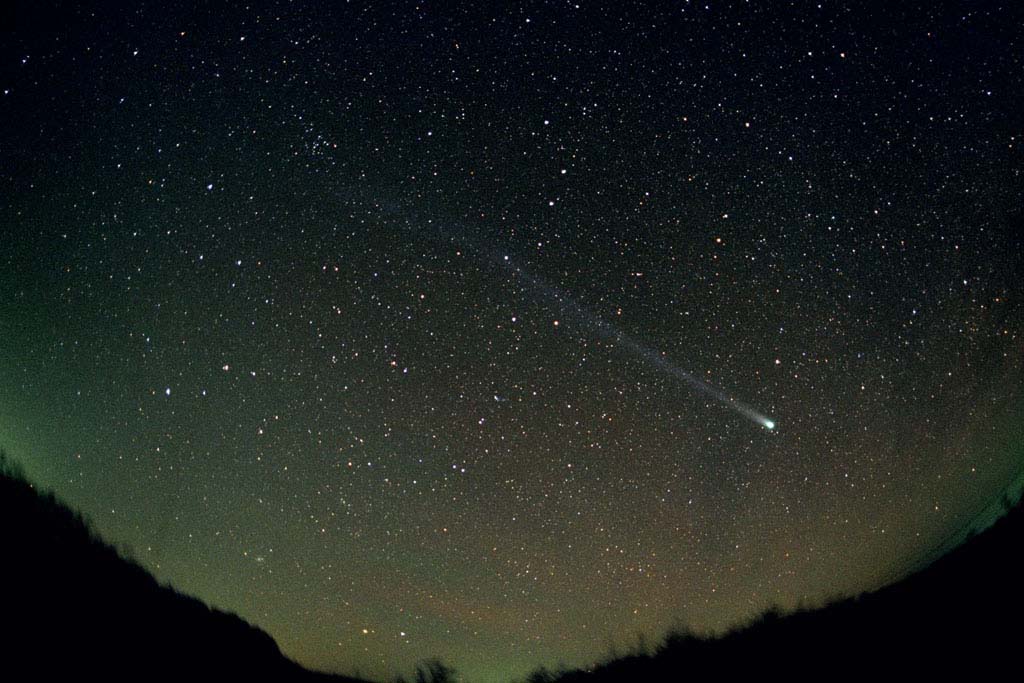
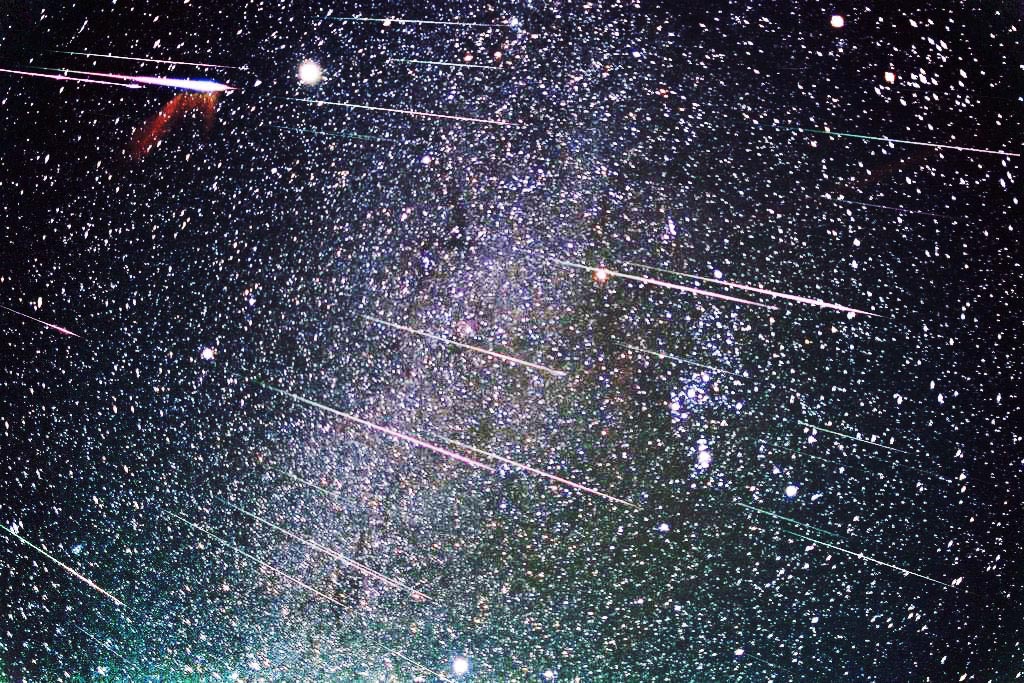
My wife hardly ever had a chance to come
with me to observe the stars, because she
was busy with her work as a school nurse and with bringing up two daughters of
ours.
On March 28, 1996, however, she and our
daughters came with me. Newly discovered
comet Hyakutake was rapidly approaching the earth, and in the city it was seen
only as
a small comet. When we reached the observation spot in the mountains, which is
700
meters high, and stepped out of the car, we were stunned! “Who left a
broomstick in the sky?”
I cried to myself. In the dark sky, the tail of Comet Hyakutake stretched half
way across the sky!
It was the very comet I had been longing to see, since I missed seeing Comet
Ikeya-Seki
in my high school days.
I used a diagonal fisheye lens, whose
view is 180 degrees wide. So, the tail of the comet
is about 100 degrees long, stretching from Polaris, through the Big Dipper and
almost reaching
the constellation of Coma.
Another time when she came with me was
on November 18, 2001, when Leonid shower was
predicted. Just as British astronomer David Asher predicted, thousands of
shooting stars were seen.
Though it was freezing cold in the mountains, the sky was clear and there was no
wind.
Toward the morning, everything was covered with frost, but many people kept on
shouting every
time a shooting star went across the sky. My second daughter was with us, too,
and on the
following day she was late for school; the only case where she was late for
school for other reasons
than illness.
07. “Recovery from
Disappointment”
(Great Prominence 1999)
On August 11, 1999, Dr. Demiya came to
Iran with me to see the total solar eclipse for the
first time in his life. He was a 79 year old physician for a small town with
many people depending
on him, so he never left Japan except for WWII where he was an army doctor. His
son, also a physician,
began to help him at his clinic and at last he had some spare time to go abroad.
He brought his
telescope and camera all the way to Iran, but he couldn’t take a single picture
of the eclipse.
Somehow, his camera was set on automatic focus, the camera continued seeking,
but failed to find
the right focus, all through the darkness of the three minute eclipse. In the
confusion Dr. Demiya
didn’t even see the eclipse. His camera was complicated with automatic focus he
realize sometimes
its just better to have a simple camera.
His yearning for the sun grew so great
that he bought an expensive Coronado filter to see the
prominence of the sun. In January, 2001, I asked him to bring the telescope to
our monthly astronomy
club meeting. It was a snowy day, but sometimes the sun broke through the
clouds. At first a small
red prominence was seen on the edge of the sun, but two hours later, I was
amazed to find that it had
grown into a giant arch prominence! Thanks to his persistence in photographing
the sun daily, Dr. Demiya
quickly photographed the prominence, and it was awarded the best picture of the
month in an astronomy
magazine “Tenmon Guide”. The commentator said that the picture would be
recorded in the history of
amateur astronomy, and he wished he had been there with us to witness this very
rare phenomenon.
08. Special Birthday
Present
(Jupiter and its satellites)

On April 11, 2004, Mr. Fujita came to
visit me with his 15cm refractor telescope.
He was afraid that his telescope was not well collimated. He sent it back to
the maker,
Borg Co., and had it collimated again, but he still though that it may be out of
collimation.
In my backyard, I aimed the telescope at
Jupiter, and I was amazed. The seeing (the stability
of the air) was exceptionally good, and I could see the details of Jupiter. I
put a web camera
(Philips ToUcam Pro) to the telescope at once, and began to take the images.
Pictures
were taken every five minutes, and for every picture, 1500 frames of images were
stacked and processed.
Satellites and their shadows were seen
going around Jupiter. The great red spot appeared
and the rotation of Jupiter was clearly visible. I proved that Mr. Fujita’s
telescope was very
excellent, and it was also a special present for my 57th birthday.
09. Dr. Demiya Saves
My Life
(Diamond Ring and Corona, 2009)
On March 27, 2006, Dr. Demiya and I were
in the same room of a hotel in Tripoli, Libya.
We were scheduled to see the total solar eclipse in the desert two days later.
Unfortunately, however, I suddenly had a heart attack and fell down. As a
doctor,
he quickly took necessary procedures and my life was saved. I was hospitalized
in Libya
for two weeks and managed to come home safely.

On July 22, 2009, I was on board a ship
called the “Fuji-maru”, with Dr. Demiya.
On the deck of the ship, we successfully observed the longest total solar
eclipse in
the 21st century. Through binoculars, the white corona of the sun revealed its
very
fine structures.
On November 14, 2012, I was on a hotel veranda in Cairns, Australia with
Mr. Demiya
to see another total solar eclipse, but the view was prevented by clouds.
Dr. Demiya is 92 years old now, and he is looking
forward to seeing yet another eclipse.
10. Dawn and Dusk at
the Same Time
(Total Solar Eclipse in the Pacific, 2009)

On July 22, 2009, during the total solar
eclipse, I took this 360-degrees photo of the sky.
In the middle of the day, night suddenly came, and all around the horizon, one
could see
dawn and dusk at the same time. Though it was night where I was standing, it
was day
one hundred kilometers away.
In order to obtain the fine gradation of
light on the horizon, I used a large format film,
4x5(10x12.5cm). I used a fish eye lens of Pentax 6x7 camera; focal length 35mm,
focal ratio4.5.
I made the camera box myself with a wooden board. I used the finest grain film,
Fuji Velvia
transparency film. I boarded a ship at Himeji Port near Kobe, we sailed for two
days,
arriving at the best spot to observe near Iwo-jima Island. Even though ships
are unstable,
they can move and evade obstructing clouds.
In order to see 360 degrees of the
horizon, I had to be on the top deck of the ship, which is
usually forbidden for passengers. Light can leak through my hand made camera,
so I set the
film holder during the totality of the eclipse. Two sheets of film can be
loaded on either side
of the holder. After I made 1-second exposure on one film, I turned over the
holder, and made
two-second exposure on the other film. I removed the lens cap as the shutter.
On the two-second exposure film, I
captured the corona of the sun’s eclipse in the center
of the photograph, with Venus to the right, Mercury to the left and Sirius to to
the south.
One can also see in the photo the fine gradation of dawn and dusk in the
360-degree horizon.
In the photo one can see twilight to the east (left) while at the same time on
the lower right
of the photo dawn. Usually this is impossible to see.
